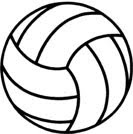If you were to demonstrate to a new player how you want the volleyball to be passed, would you:
A) Turn your back to your setter and pass the ball back over your head?
B) Turn sideways to the flight of the ball and swing at it like a baseball batter?
C) Stretch straight up and hit the ball with the knuckles of one hand?
D) None of the above.
Geez. I hope you answered "D".
But how many times have you seen a player fail to move his feet or turn sideways or entirely backward to the setter while attempting to pass the ball? How accurate are the passes made this way compared to the passes made by players who get both feet in front of the ball and are able to pass from a crouching stance instead of facing mostly away from their setter and twisting and stretching backwards?
Passing the ball from a sideways or backward stance poses many inherent problems:
Problem 1. You face farther away from your setter than if you get in front of the ball.
Problem 2. You might be stealing the ball from a teammate who is in the better position to make the pass.
Problem 3. You risk a collision and injuries with teammates when you are out of position to play a ball -- because when it appears that you are out of position to make the play, your teammates will try to make the play.
Problem 4. You set up the fake-out: You attempt to play the ball, realize you don't have as good a chance at it as a teammate so you stop your attempt but your teammate has already stopped her attempt, too, because she thought you were committed to the ball.
Problem 5. When you appear to be out of position to play a ball -- and especially if it looks like you and a teammate will both attempt to play the same ball -- your other teammates lose confidence in whether the play will be made. This throws off the timing of the setter and the approaches of the hitters.
You can fight off a tendency not to get in front of the ball by (1) anticipating and starting your move quickly to a position in front of the flight of the attack hit and (2) striving for that good passing position instead of just any ol' position that allows you to touch the ball.
Simple drill: Two people. Stand facing each other. Start the drill any distance apart but vary the starting distance as you repeat the drill. One player lobs the ball just high enough for the other player to rush into a good passing position, fully in front of the path of the ball and facing the person who lobbed the ball. The second player passes it back to the first. With three people, one lobs it over the head of the second. The second one rushes to get in front of the ball, passes it to the third (as though this person would be setting). The third person catches it and lobs it over the head of the first person who rushes to get in front of the ball, etc.
The goal for you is to lose the habit of passing lazily and to build the habit of passing as though the whole match depended on it.
Thursday, August 19, 2010
Subscribe to:
Posts (Atom)




